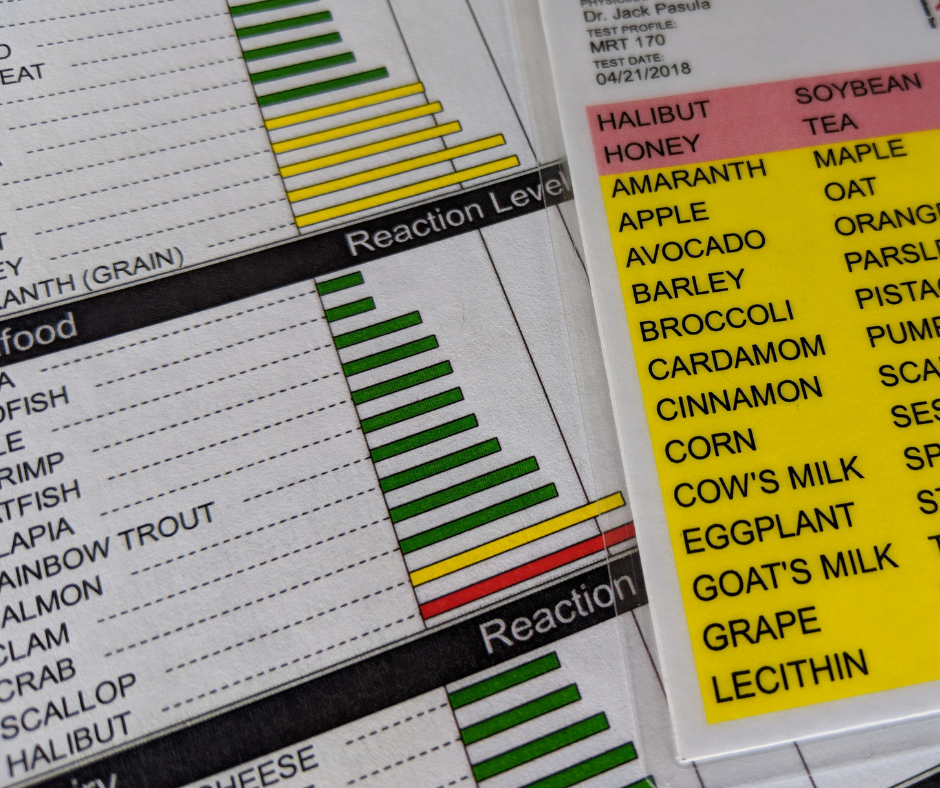There is a lot of talk in the health field about elimination diets versus food sensitivity testing. Elimination diets have been considered the gold standard for the longest time but is that really the best option?
I used to be on the anti-food sensitivity testing side of the fence. I went through the AIP practitioner course and was therefore able to lead my clients through the autoimmune protocol diet. This is an elimination diet protocol that removes common immune triggers that promote inflammation in the gut, thereby mitigating autoimmune flare-ups. However after much research as well as clinical experience, I started implementing the Mediator Release Test (MRT) food sensitivity test in to my practice.

Now with experience in leading clients through multiple means of determining food sensitivities, I feel equipped in sharing a bit about my experience along the way. Let’s first discuss the MRT and then I’ll share my experiences with both – and you may be a bit surprised!
What is MRT?
MRT is a blood test that is used to estimate your immune response to 170 different foods or food chemicals. It is one of the most accurate food sensitivity test currently available to identify foods, additives, and chemicals that are causing sensitivity reactions (sensitivity of 94.5% and specificity of 91.7%).
It’s a bit different than your typical antibody testing that your doctor might run because it’s testing for the mediators that are released in response to sensitivity. These mediators include histamine, prostaglandins, cytokines, among others – all of which can have a negative impact on our physiology. It’s the presence of these mediators that become the actual cause of the symptom in the person. MRT quantifies all of these reactions rather than focusing on just one marker, such as IgG. Interestingly enough, some evidence shows that presence of IgG actually indicates a tolerance to that food, so simply testing IgG alone wouldn’t provide sufficient information.
LEAP Protocol
It doesn’t stop with the testing. The next step is tailoring a nutritional protocol for the individual based on their results. The most common mistake I see individuals make is that they’ll take their results and solely avoid the foods that came back positive. The problem with this approach is that there are thousands of foods and food chemicals on the market today. There are still going to be foods that are not tested, which I refer to as unknowns. By only avoiding foods that are positive, you may still be consuming something in which you’re sensitive.
This is where the LEAP protocol comes in, which is designed to work backwards to allow your immune and digestive system to calm down and then gradually reintroduce foods one at a time, working your way back to an expanded diet.
Elimination Diets, AIP, and MRT – oh my!

A basic search for elimination diet will yield an assortment of conflicting information. For the most part, you may see a basic gluten and dairy elimination to something more strict, such as the AIP diet, which has quite a few restrictions.
A benefit to elimination diets is that is often the entry point for an individual to taking their health back in their own hands. It allows us to discover how food affects our body and that is a really cool thing! A less restrictive elimination can extremely beneficial for many clients, especially those who need a gradual approach. Protocols such as AIP is premised around the leaky gut – autoimmune connection and advocates for gut healing and nutrient-dense foods. These are basic nutritional principals that I think more people need to hear!
Where I find the downfall on elimination diets is that in being a standardized protocol, it can be difficult to follow! Here you are eliminating foods/food groups for extended periods in the hopes that they’re the right foods. I’ve seen individuals on an elimination diet for extended periods but still experiencing symptoms and it came back as they were sensitive to some random food that was still “legal” according to their elimination diet. Everyone’s body responds differently!
There’s also concern that overly strict elimination diets may set the stage for poor food relationship and/or disordered eating. I’ve seen some clients who’ve been on AIP for over a year. I can’t blame them though — they went on the diet and noticed significant improvement and it can understandably be downright scary to reintroduce foods back in.
While the MRT+LEAP is restrictive upfront, the most intense phase in only two weeks. It’s more streamlined in that the protocol is built based around your body’s own unique response to foods. Even better, the focus is on what you are eating, not what you’re avoiding.
We know diet is not one-size-fits-all and that goes for elimination diets as well. By blending the LEAP protocol alongside proper digestive support and gut healing protocols, an individual will have a customized roadmap to regain health!
What Next?
If you’ve been interested in pinpointing foods that may be triggering your symptoms, I first suggest working with someone one-on-one through the process. It’s tempting to DIY-it since we have so much information at our fingertips. However a professional will be there to assist in customizing that roadmap to your needs. If food relationship is an issue, then working with someone will help ensure you’re meeting your needs in all areas – nutritional, emotional, and spiritual.
Finally, I always suggest checking in on our mindset before going in on any protocol and again checking in throughout the journey. Rather than focusing on food as the enemy, it’s important to shift the energy to healing the body so that we can enjoy an array of foods, just without the symptoms!
Questions? Let’s talk. Schedule a complimentary session.